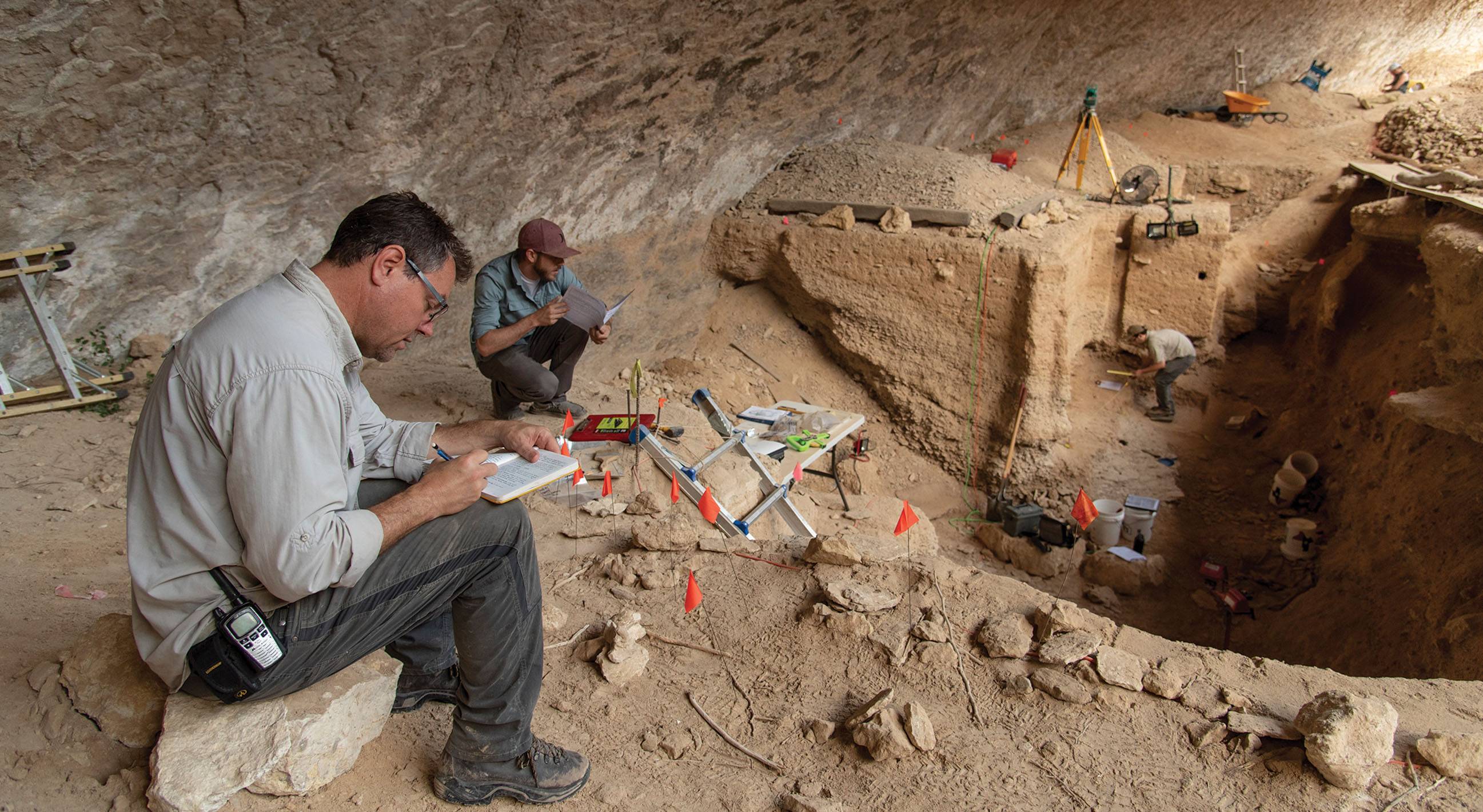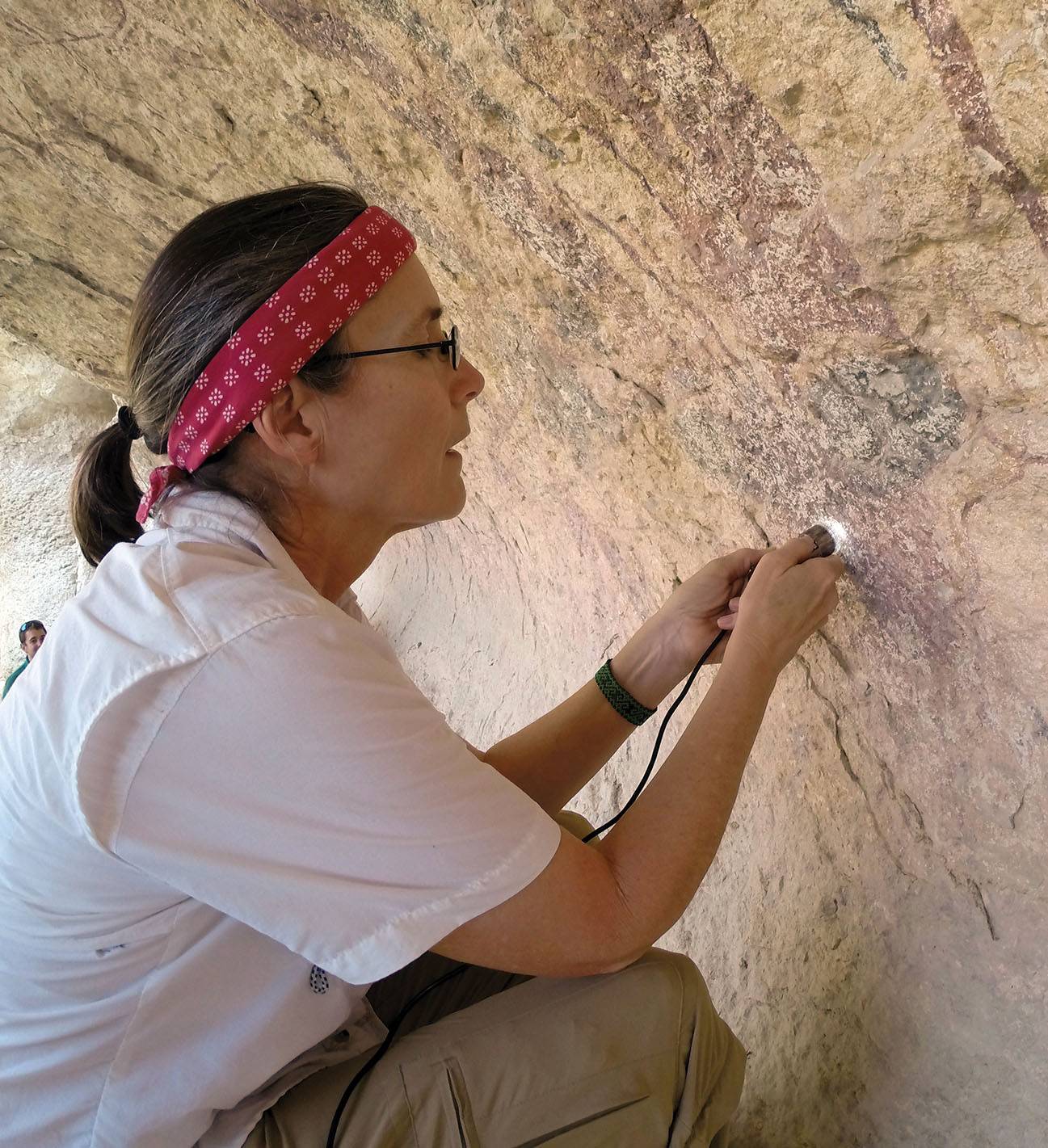Archaeology Field School Opens Window to the Past

Archeology Field School Opens Window to the Past
By Mary S. Black
Students discover the world of ancient Texans
In the thorny desert along the Mexican border west of Del Rio, Texas State University students are learning methods of field archaeology and rock art recording and preservation. Dr. Carolyn Boyd, Shumla Endowed Research Professor, and Dr. David Kilby, associate professor, both in the Department of Anthropology, are leading this unusual joint field school.
Students will collect samples of bone and dirt at the Bonfire Shelter site, identify and record new archaeological sites, dig test excavation units of prehistoric rock ovens used for baking desert plants, and build 3D models of these archaeological features from photographic imagery. In addition, they will precisely document rock art and learn cutting-edge research and preservation techniques, such as creating gigapixel panoramic photos of rock art murals and analyzing paint stratigraphy using digital microscopy. These experiences cannot be gained in a classroom, but in the rugged landscape of southwest Texas.
Kilby is working at Bonfire Shelter, at the end of a short box canyon where Native Americans stampeded bison off a sheer cliff about 3,000 years ago. A lower bone bed deposit, about 12,000 years old, suggests a much earlier jump event as well, perhaps orchestrated by distant ancestors.The people who hunted these animals 3,000 years ago also painted large polychrome murals in rock shelters in the canyons flowing to the Rio Grande. Over 30 experimental radiocarbon dates show the murals to be between 4,000 to 2,000 years old. Boyd has spent 25 years trying to understand these paintings using the methods of both art and science.

“Bonfire is difficult to access,” says Kilby. “The nearest town of any size is an hour away, and every day we have to climb down the cliff face on a narrow, steep trail, or use precarious ladders. It is difficult to get equipment in and out. Last year, we built a crane from a truck winch bolted into the rock on the rim and used a big basket to lower equipment and haul up bone and dirt samples. Heat in the canyons is also a problem, but inside Bonfire itself, it is always cool. In fact, it used to be called ‘Icebox Cave’ because of this quality.”
Most rock art locations are also difficult to reach. Some are in precarious overhangs on steep cliffs overlooking the Rio Grande or the Devils and Pecos rivers and their tributaries. The paintings were made on limestone walls using four colors of natural pigments — black, red, yellow, and white — often with bold enigmatic designs. Some are as much as 14 feet high and stretch over the entire wall and ceiling of a rock shelter.
One of the most exciting discoveries for Boyd came when she saw how the colors were systematically applied to the design. Contrary to earlier ideas that the paintings were little more than ancient graffiti, she realized that black pigment was applied first, followed by red, then yellow, and white last. This meant that the original artist had thoughtfully planned the entire composition. Using a digital microscope to observe minute details, she has documented this sequence at White Shaman shelter and Rattlesnake Canyon. About 98 percent of the samples showed that black paint was always applied first, followed by the other colors, suggesting a ritual formula in the artwork.
Early in her career, Boyd trained as an artist, so she brings the eye of a painter to these remote reminders of past lives. “I was able to understand composition, elements of design, and technical aspects, such as the need for scaffolding to paint the ceilings of these large limestone shelters. It wasn’t until we applied new technology, however, that we were able to prove what the artist had already perceived. We’ve bridged science and art.” Both are essential in her work.
Boyd believes the function of the murals is to communicate sacred information to the viewers. It’s easy to imagine people gathered near one of these images to hear the stories of the gods reenacted by the elders, drums beating, fires burning, and songs being sung. One of the major stories told by these primeval paintings concerns the birth of the sun each morning from the dark underworld, opening the universe to human life.
“The murals in this area are a window to the past,” Boyd explains. “Through them we’re able to understand the origin and tenacity of myth. We’re able to understand the stories or narratives of 4,000 years ago, the complexity of our ancestors. They had a highly sophisticated belief system, as well as a library of information on astronomy, botany, and other aspects of the environment.”
“We’re studying aspects of the same people,” says Kilby.
“The people were the same,” Boyd agrees. “Their stories were the same. We are working to put a face on the people of the Lower Pecos.”
After many years of work, “I started seeing patterns in the rock art,” she explains. “One attribute found with another attribute over and over again. When I read about the Huichol Indians in Mexico, I started to see the same patterns. I’ll never forget showing the White Shaman Shelter to Huichol elders and having them say, ‘Yes, there is Father Sun. This is telling the story of our people.’ The core of these stories is still being told today by Indians in Mexico.”
Kilby also studies ancient stone tools, particularly caches of Clovis projectile points from about 13,000years ago. No Clovis tools have been found at Bonfireor in the Lower Pecos, but Paleoindian points dating to about 12,000 years ago have been recovered there, including several Folsom points.
“We’re trying to minimize our impact at Bonfire,” says Kilby, by stabilizing a series of pits dug in the 1960s and 1980s and the beds of burned bison bones. Continuing the goals of the Ancient Southwest Texas Project, led by Dr. Steve Black, also of Texas State, students will learn preservation techniques to save these remains for future archaeologists to analyze with improved technology and new ideas. Kilby has been working at Bonfire for more than two years and anticipates at least another year with support from a Texas State Research Enhancement grant, the National Geographic Society, and others.
“Ultimately students are learning aboutprehistoric cultures and their adaptations to life in the Chihuahuan Desert, thousands of years of human experience — what they ate, how they got it, their subsistence, and their belief systems through the art. It’s critical in liberal arts to expose students to other cultures and norms, and other ways of thinking. Archaeology and anthropology expose people to vast cultural diversity,” says Kilby.
Field school students are discovering and preserving relics from a way of life very different from our own. Such concrete experience builds respect for other people, cultures, and beliefs in deep, tangible ways.
“There are so many theses and dissertations waiting to come out of here, I don’t even know where to begin,” says Boyd. Every one of the staff archaeologists at the Shumla Archaeological Research & Education Center — the primary Lower Pecos rock art research facility she founded in Comstock — are from Texas State.
“The finest of the students come from our university. As far as I’m concerned, there is no university in the state that can hold a candle to Texas State in terms of thinking outside the box,” Boyd says. ✪